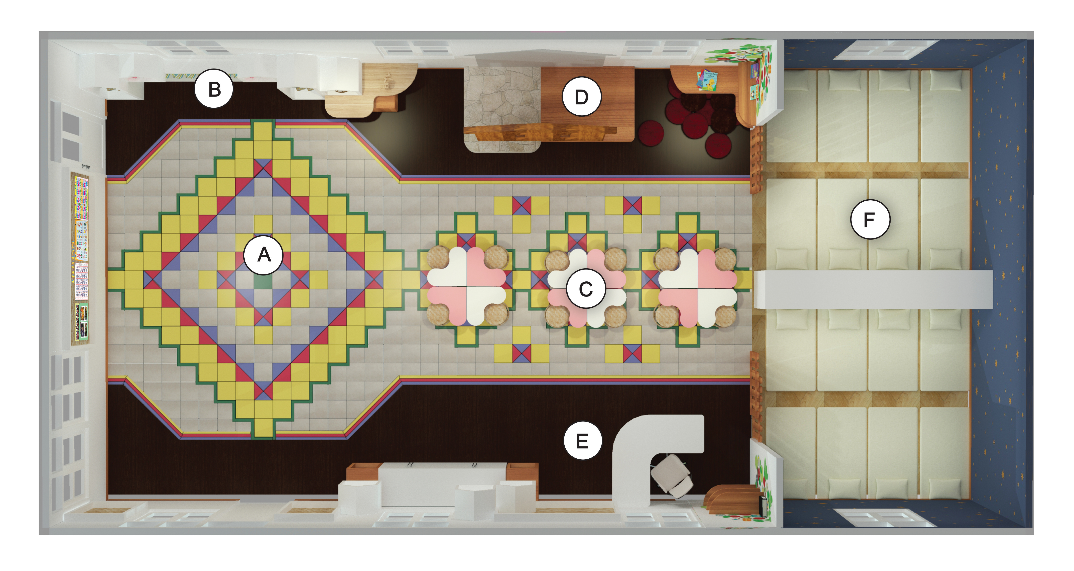Classroom Space Design to Enhance Learning in Pre-school Children, Highland Phayao Province
Main Article Content
Abstract
The population of children in the highlands of Phayao Province grows at a high rate every year. It was found that the pre-school children faced problems of self-preparation for learning in schools due to two main factors: traveling and the readiness of their family. This paper aims to form activity program and design classroom activity space through studying the learning behavior of highland pre-school children in Baan Pang Poo Lo, Phayao Province. Data are collected from three population groups: children age 3-5 years, teachers, and parents. The study found that learning activities in the classroom consist of 7 main types, using 4 areas in the classroom. Therefore, more space within a classroom should be allocated to these activities and arranged the accessibility of each area by 1) High activity area for activities that develop large muscles, cognitive skills, language skills as well as emotional and psychological growth 2) Reading and writing area for activities that develop imagination and creativity 3) Independent area for activities that develop small muscles 4) Storage area for activities that develop social skills. The areas are arranged so that the high activity area is connected and accessible to all areas to encourage emotional and psychological development and learning of pre-school children in the highlands.
Downloads
Article Details

This work is licensed under a Creative Commons Attribution-NonCommercial-NoDerivatives 4.0 International License.
All material is licensed under the terms of the Creative Commons Attribution 4.0 International (CC-BY-NC-ND 4.0) License, unless otherwise stated. As such, authors are free to share, copy, and redistribute the material in any medium or format. The authors must give appropriate credit, provide a link to the license, and indicate if changes were made. The authors may do so in any reasonable manner, but not in any way that suggests the licensor endorses you or your use. The authors may not use the material for commercial purposes. If the authors remix, transform, or build upon the material, they may not distribute the modified material, unless permission is obtained from JARS. Final, accepted versions of the paper may be posted on third party repositories, provided appropriate acknowledgement to the original source is clearly noted.
References
Ann, H., & Joyoe, L. (1981). The early childhood center. as cited in Manthana, T. (n.d.). Bangkok: Department of Preschool Education, Suan Dusit Teachers College.
Barnett, W. S., Schulman, K., & Shore, R. (2004). Class size: What’s the best fit?. New Jersey, United States: Preschool Policy Matters.
Boonsong, S. (1980). Developmental psychology. Bangkok: Thai Watana Panich Publishing.
Buranakanita, S. (1987). Children: Infants-preschool, Theory and practice (1st Ed.). Bangkok: Borpitta Publishing.
Department of Public Welfare Ministry of the Interior. (1976). The living conditions of the people in his country. Bangkok: Pakret Women’s Shelter Publishing.
Gaines, K. S., & Zane, D. C. (2011). The inclusive classroom: The effects of color on learning and behavior. Journal of family & consumer sciences education, 29(1), 46-57.
Khuruawan, S., & Team. (n.d). Development of families and kids. Bangkok: Srihong Publishing.
Mayuree, N., & Sripri, S. (1981). “Collision of cultures” tribe. Bangkok: The Prime Minister’s Office.
Ministry of Education. (2004). Course guide to early childhood education Act. 2003 for ages 3-5 years (1st Ed.). Bangkok: Author.
Prommate, S. (1991). Hill tribe in Thailand (5th ed.). Bangkok: Ramkhamhaeng University Publishing.
RI Department of Education. (2013). Comprehensive early childhood education (Standards for Approval of Preschool and Kindergarten Programs). Rhode Island, USA.: Author.
Romyanond, B. (2015). Design for self-directed learning spaces in university case study at Thammasat University, Rangsit, Thailand. Journal of Architectural Research and Studies, 12(1), 15-28.
Touprakhon, P. (2016). The prohibition of Yao hill tribe. Chiang Mai: Tribal Research Institute in Chiang Mai.
The Support Arts and Crafts International Center of Thailand Public Organization. (2014). Characteristics and patterns of hill tribe fabric. Bangkok: Siam Asia Print.
Tiengtham, W., & Boonsue, A. (2014). Effects of organizing outdoor activity provisonusing traditional toys based on sensory integration approach to promote motor skills of kindergarteners. An Online Journal of Education (OJED), 9(1), 473-487. Retrieved from http://www.edu.chula.ac.th/ojed.
Watson, J. B. (1997). Behaviorism. London: n.d.


